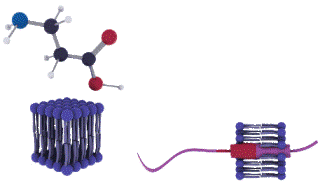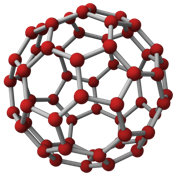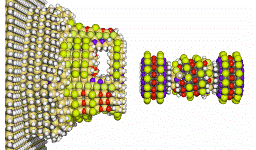Nanotechnology:
The prefix "nano" stems from the ancient Greek word for "dwarf". In science it means one billionth (10 to the minus 9) of something, thus a nanometer (nm) is one billionth of a meter or you can say it is 0.000000001 meters. A nanometer is all about three to five atoms wide or several 40,000 times smaller than the thickness of human hair. A virus is naturally 100 nm in size.

Generally nanotechnology is defined as the research and expansion of devices, materials and systems exhibiting physical, biological and chemical properties that are different from those found on a larger scale (matter smaller than scale of things like molecules and viruses).
The capability to manipulate structures and properties at the nano scale in medicine is like having a sub-microscopic lab bench on which you can manage cell components, viruses or pieces of DNA, using a range of tiny tools, robots and tubes.
History of Nanotechnology:
In 1959 dream of nanotechnology is introduced by late Nobel Physicist Richard P Faynman. He recommended nanorobots, nanodevices and nanomachines ultimately could be used to develop a wide range of atomically precise microscopic instrumentation with manufacturing tools could be applied to produce vast quantities of ultra small computers also various nanoscale microscale robots.
Feynman's thought remained largely un-discussed until the mid-1980s once the MIT educated engineer K Eric Drexler published ‘Engines of Creation' it is a book to popularize the prospective of molecular nanotechnology.
Future opportunity of nanotechnology on medicine and dentistry:
Increasing interest in future medical applications of nanotechnology is leading to the appearance of a new field called Nanomedicine. Nanomedicine required overcoming the challenges for its application, to advance understanding of pathophysiologic basis of disease bring more sophisticated diagnostic opportunities also yield more effective therapies and preventive properties. When doctors gain admittance to medical robots they will be able to speedily cure most known diseases which hobble and kill people today to speedily repair most physical injuries our bodies can suffer and to vastly extend the span of human health. Molecular technology is destined to become the core technology underlying all of 21st century dentistry and medicine.
Nanomedicine:
The field of "Nanomedicine" is defined as: it is a science and technology of treating, diagnosing and traumatic injury and preventing disease of relieving pain and of preserving and improving human health using nanoscale biotechnology, structured materials with genetic engineering and eventually complex machine systems and nanorobots. It was perceived as embracing five main sub disciplines that in many ways are overlapping by common technical issues

Nanomedicine is the medical technique of nanotechnology. Nanomedicine varies from the medical techniques of, to nanoelectronic biosensors, nanomaterials and even possible future techniques of molecular nanotechnology. Existing problems for Nanomedicine comprise understanding issues which is related to toxicity and environmental impact of nanoscale materials (materials whose structure is on the scale of nanometers that is billionths of a meter).
From the US National Institutes of Health Nanomedicine research is receiving funding. Of note is the funding in 2005 of a 5 years plan to set up for centers of Nanomedicine. In April 2006 the journal Nature Materials estimated that 130 nanotech-based drugs and delivery systems were being developed worldwide.
Nanotechnology in Medicine - Nanomedicine:
The utilization of nanotechnology in medicine offers some thrilling possibilities. Some technologies are only imagined whereas others are at different stages of testing which is actually being used today. Nanotechnology in medicine comprises applications of nanoparticles which is presently under development also longer range research comprises use of manufactured nano-robots to make repairs at cellular level.
Whatsoever you think, the use of nanotechnology in the field of medicine could revolutionize the way we detect and disease in the future and treat damage to the human body also many technologies only imagined a few years ago are making remarkable progress towards becoming realities.
Drug Delivery: Medicine Application of Nanotechnology:
Nanotechnology has provided the opportunity of delivering drugs to specific cells using nanoparticles. In general drug consumption and side-effects may be lowered significantly by depositing the active manager in the morbid region only and in no higher dose than needed. This extremely selective approach would decrease suffering of human also costs. An example can be found in dendrimers and nanoporous materials. This technologies reduces damage to healthy cells in the body also allows for previously detection of disease.

For eg: Nanoparticles that deliver chemotherapy drugs to cancer cells are under development. Tests are in advancement for targeted delivery of chemotherapy drugs also their final approval for their use with cancer patients is pending. One organization, CytImmune has published the preliminary results of a Phase 1 Clinical Trial of their 1st targeted chemotherapy drug whereas another organization BIND Biosciences has published results of a preliminary Phase 1 Clinical Trial for their 1st targeted chemotherapy drug and is proceeding with a Phase 2 Clinical Trial.
Conclusion:
Once Nanotechnology is obtainable the ultimate dream of each and every healer man of medicine and physician throughout recorded history will at last become a reality. Controllable and Programmable microscale robots comprised of nanoscale parts fabricated to nanometer precision will allow medical doctors to execute curative and reconstructive procedures in the human body at the cellular and molecular levels. Nano-medical physicians of the 21st century will still make good use of the body's natural healing powers and homeostatic mechanism as all else equal to those interventions are best that intervene least.